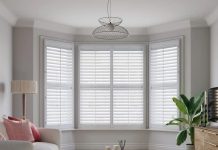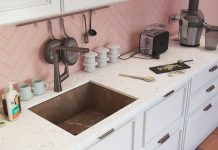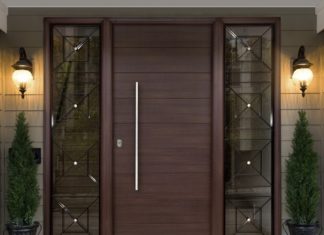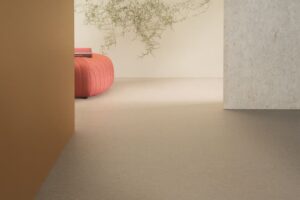
The healthcare industry faces a unique set of challenges when it comes to choosing flooring. There are many areas to accommodate within each facility, so it’s important to know all the features of the possible hospital flooring options. Considering the main boxes that a hospital flooring should tick (durability, longevity, cleanability, comfortability underfoot, point load and rolling load requirements, etc.), here are 5 flooring options that are regarded as the most suitable for healthcare institutions.
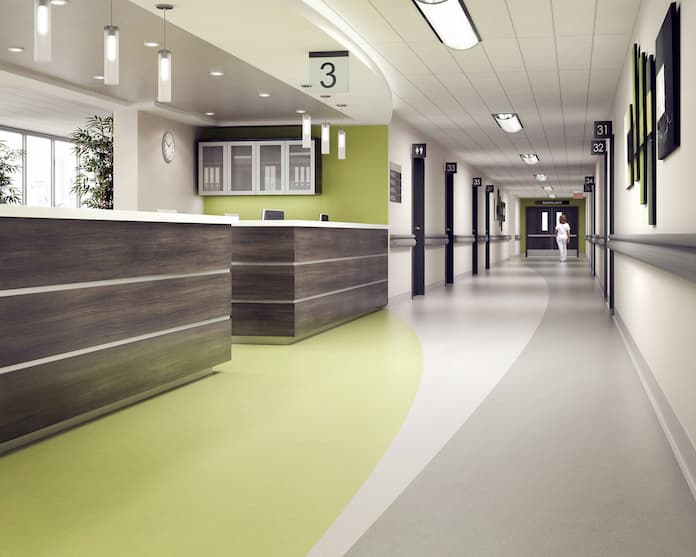
Vinyl
The first option on this list is the high-quality vinyl flooring for hospitals, and for very good reasons. It meets the very specific requirements of surfaces in hospital interiors. Vinyl flooring is easy to clean and maintain and its unique antimicrobial properties make it ideal for hospitals to maintain the high levels of sanitisation required. When it comes to cleaning, wiping or vacuuming is sufficient for this flooring type on a daily basis. Once a week, it’s also necessary to wipe it with a damp mop or a cloth moistened with warm water and a neutral detergent.
Considering the fact that flooring in hospitals is exposed to heavy traffic 24 hours a day, hospital floors need to be super sturdy, and vinyl has long proven to be up to the task. It is durable, strong, safe, shock-absorbent, and comfortable to walk on.
When it comes to vinyl flooring for hospitals, you can choose between different types – the most common ones being luxury vinyl flooring (LVT), sheet vinyl and vinyl composition tile (VCT). It is safe to say that LVT is one of the most popular flooring products these days. It’s waterproof, easy to install, extremely durable, and excellent in high traffic areas. Commercial LVT uses a photographic print process on the tile, thus allowing for almost endless design possibilities.
On the other hand, sheet vinyl allows for a minimal number of seams and this is a great choice for areas where aesthetic is a concern. Plus, this surface is smooth and won’t gather dust and bacteria in hard to reach seams.
Then, there’s the economical vinyl flooring option – VCT. Vinyl tiles are a mixture of natural limestone, colour pigments, fillers, and a thermoplastic binder. Even though this tile is extremely durable, it requires more maintenance than other vinyl flooring types, including stripping, waxing, polishing.

Rubber
Rubber flooring has become quite popular in hospital settings. This flooring is equipped with all the necessary properties required for hospitals. It provides a high level of abrasion resistance which enables use in heavy traffic areas, even for a long period of time. Its dense surface structure provides strength under pressure, standing up to even the toughest hospital conditions without sacrificing style.
Rubber flooring elevates interiors with seamless installation, exceptional durability and a variety of design choices. How long does rubber flooring last, you ask? This material is resilient, tough and strong, and with proper care it typically lasts about 20 years.
Linoleum
Linoleum is a green product made with natural material, such as cork dust, linseed oil, and jute fibre. It has respectable antimicrobial properties to protect against germs. Linoleum has the ability to meet the rigorous requirements for sterile environments found in intensive care, emergency and operating rooms. It can handle high traffic with minimal signs of wear and tear.
One of the major advantages of linoleum is that it is produced in sheet. Sheet application allows for minimal seams so there are fewer chances for bacteria to hide in floor seams. This advantage allows for better maintenance options when compared to other flooring types. For proper care, you just have to regularly sweep and mop it with hot tap water where you add either vinegar or a commercial linoleum cleaner. After mopping, dry the floor promptly with a towel.
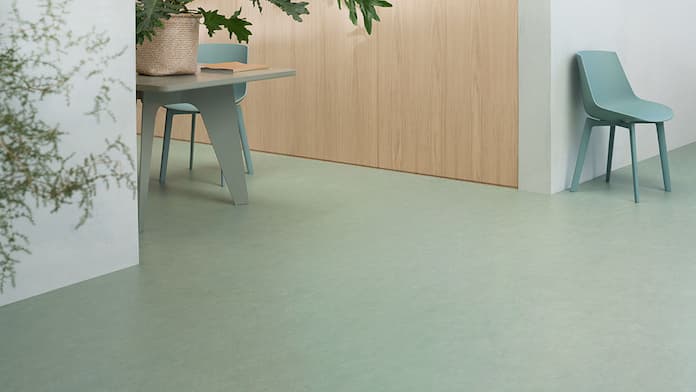
Terrazzo
Another highly durable flooring option for hospitals that requires minimal maintenance is terrazzo. When properly maintained, terrazzo floorings can last for years. What makes this floor type a good choice for hospitals is its ability to stand up well to rolling load, provides anti-slip characteristics, is handicap-friendly, and is available in recyclable materials.
When properly sealed, terrazzo is non-porous and mould-resistant, which in addition helps keep hospitals sanitary and decreases the risk of infection. With the elegant and timeless look, terrazzo flooring significantly enhances hospital areas with a diverse range of options and colours to create detailed floor patterns. This flooring type is commonly found in hospital entrance areas and corridors, nurses’ stations, patient and emergency rooms.
Epoxy Resin
This is a durable plastic surface covering made up of synthetic resin and a separate hardener. If the building requires a more durable flooring, then the resin floor needs to be made thicker. In this case, the range of ingredients grows to include aggregates, decorative flakes, pigments, and in certain cases, cement powder.
There are 3 main types of resin flooring: epoxy, polyurethane and cementitious. The first type is the most popular and widely distributed resin flooring type in industrial settings. It is recognized for its reliable performance and durability. Epoxy resin flooring is very hard, bonds fully to concrete and protects the underlying concrete base from wear, impact, water ingress, abrasion, oil and a range of chemicals. However, if it gets damaged over time, it must be fully replaced.

